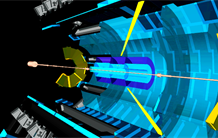Light-by-light scattering, predicted in 1936, was observed for the first time by the ATLAS experiment at the LHC, thanks to "ultra-peripheral" collisions of lead ions. It is of particular interest to physicists, as it is the result of interactions between a vacuum and intense electromagnetic fields.
According to electromagnetic theory, the four-photon reaction γ+γ→γ+γ is impossible because two waves emitted by incoherent sources do not interfere. Yet extreme electromagnetic fields can act on a vacuum and "polarize" it. The vacuum can, in turn, induce non-linear effects on the fields… and make the impossible possible!
The physicists in this study looked at collisions of 5 TeV lead ions at the LHC to find events in which lead ions merely graze. The ultra-relativistic charged particles produce an electromagnetic field with high gamma-ray intensity. Since, the frontal collision is avoided, the production of several hundred particles does not occur and the extreme fields associated with the ions can, therefore, interact (1025 V/m). The team was able to isolate 13 candidates for the light-by-light scattering among four billion physics events.
Their results are in agreement with the prediction of quantum electrodynamics (QED). The scientists now have direct experimental evidence indicating that the QED vacuum differs from the classical vacuum, whereas all previous evidence of this was indirect, albeit of very high quality (Lamb and Dehmelt/Paul Nobel Prizes).
The team in charge of these measurements was supervised by a physicist from IRFU.
Contact : Laurent Schoeffel
[1] ATLAS Collaboration 2016, http://xxx.lanl.gov/pdf/1702.01625v1 soumis à Nature Physics .
[2] Courrier du CERN, 11 Nov. 2016, ATLAS spots light-by-light scattering.
• The ultimate constituents of matter › Particle physics at colliders
• The Particle Physics Division
• ATLAS


